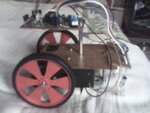rn.ksheer
Newbie level 4

- Joined
- Jan 4, 2013
- Messages
- 7
- Helped
- 0
- Reputation
- 0
- Reaction score
- 0
- Trophy points
- 1,281
- Activity points
- 1,324
Hi. I have successfully completed constructing CERBERES robot given in https://webspace.webring.com/people/bt/tjaco/cerberes/cerberes.html . The robot works well but when it comes to a corner where both the sensors sense the object , The robot seems to get confused and gets stuck in the same place. The given code doesn't have any instruction for the motors, when both sensors are active. Will it be possible to add a instruction to make the robot turn 180 degrees, then start moving forward or to come backwards, turn left/right then start moving forward when both the sensors sense the object. I am very new to programming so i would require the help.
Sorry for my English
Sorry for my English

